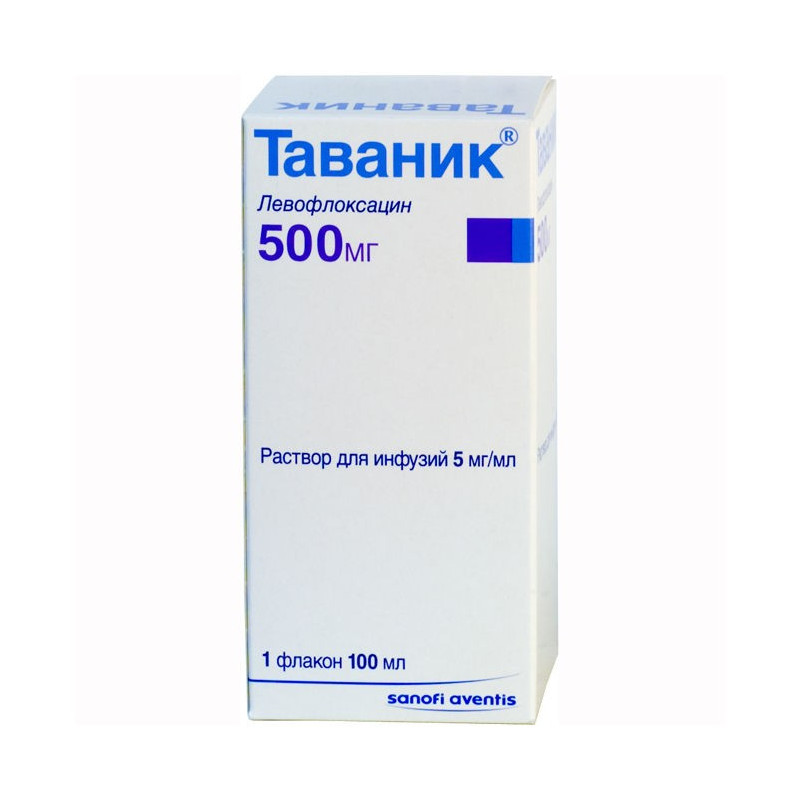



 All payments are encrypted via SSL
All payments are encrypted via SSL
 Full Refund if you haven't received your order
Full Refund if you haven't received your order
Infusion Solution
100 ml contain Levofloxacin 500 mg;
Excipients: sodium chloride, sodium hydroxide, concentrated hydrochloric acid, water for injection
Bottle of 100 ml.
Tavanic is an antibacterial drug of the fluoroquinolone group. It has a wide spectrum of antimicrobial action.
Community-acquired pneumonia; complicated urinary tract infections (including pyelonephritis); uncomplicated urinary tract infections; prostatitis; septicemia / bacteremia associated with the above indications; intra-abdominal infection.
Hypersensitivity to levofloxacin or other quinolones; epilepsy; tendon lesions in previously treated quinolones; childhood and adolescence (growth period) up to 18 years; pregnancy; lactation period.
Carefully: in the elderly due to the high probability of a concomitant reduction in renal function. Glucose-6-phosphate dehydrogenase deficiency due to the risk of hemolysis.
The drug is administered intravenously in 250-500 mg 1-2 times a day. Doses are determined by the nature and severity of the infection, as well as the sensitivity of the suspected pathogen. Tavanic solution is injected into / in drip slowly. The duration of administration of the drug in a dose of 500 mg (100 ml of infusion solution / 500 mg of levofloxacin) should be at least 60 minutes. Tavanic 500 mg / 100 ml solution is compatible with the following infusion solutions: 0.9% sodium chloride solution, 5% dextrose solution, 2.5% Ringer's solution with dextrose, combined solutions for parenteral nutrition (amino acids, carbohydrates, electrolytes). The solution of the drug should not be mixed with Heparin or solutions with an alkaline reaction (for example, with sodium bicarbonate solution). With a positive dynamics of the clinical condition of the patient after a few days of treatment, you can switch from intravenous drip to oral administration of the drug in the same dose. The duration of treatment with a / in the introduction, depending on the course of the disease is not more than 14 days.
Allergic reactions: sometimes itching and redness of the skin; rarely, anaphylactic and anaphylactoid reactions (manifested by symptoms such as urticaria, bronchospasm, and possible severe suffocation); very rarely - swelling of the skin and mucous membranes (for example, in the face, larynx), a sudden drop in blood pressure, shock, allergic pneumonitis, vasculitis; in some cases, Stevens-Johnson syndrome, toxic epidermal necrolysis (Lyell's syndrome) and exudative erythema multiforme.
Dermatologic: very rarely - photosensitivity.
Gastrointestinal: often - nausea, diarrhea, increased activity of ALT, AST; sometimes - loss of appetite, vomiting, abdominal pain, digestive disorders; rarely, an increase in serum bilirubin, diarrhea with blood (in very rare cases, this may be a sign of intestinal inflammation or pseudomembranous colitis); very rarely - hepatitis.
Metabolism: very rarely - hypoglycemia (manifested by a sharp increase in appetite, nervousness, sweat, tremors). Experience with other quinolones suggests that they can cause exacerbation of existing porphyria, in some cases, this effect is not excluded when using the drugTavanic.
Nervous system: sometimes - headache, dizziness and / or stiffness, drowsiness, sleep disturbances; rarely, depression, anxiety, psychotic reactions such as hallucinations, paresthesias in the hands, tremors, agitation, convulsions, and confusion; very rarely - impaired vision and hearing, impaired taste and smell, a decrease in tactile sensitivity.
Cardiovascular: rarely - tachycardia, a fall in blood pressure; very rarely - vascular collapse; in some cases - prolongation of the QT interval.
Musculoskeletal system: rarely, tendon lesions (including tendonitis), joint and muscle pain; very rarely - tendon rupture, for example, Achilles tendon (can be bilateral and manifest within 48 hours after the start of treatment), muscle weakness (is of particular importance for patients suffering from asthenic bulbar paralysis); in some cases - rhabdomyolysis.
Urogenital: rarely, an increase in serum creatinine level; very rarely - deterioration of renal function up to acute renal failure (for example, due to allergic reactions - interstitial nephritis).
Hemic and lymphatic: sometimes - eosinophilia, leukopenia; rarely - neutropenia, thrombocytopenia (increased tendency to hemorrhage or bleeding); very rarely - agranulocytosis and the development of severe infections (accompanied by persistent or recurrent fever, inflammation of the tonsils and persistent deterioration of health; in some cases - hemolytic anemia, pancytopenia.
Other: sometimes asthenia; very rarely - fever, allergic pneumonitis. Any antibiotic therapy can cause changes in the microflora (bacteria and fungi) that are normally present in humans.
Local reactions: often - pain at the injection site, redness, phlebitis.
It is recommended to continue taking the drug Tavanic for at least 48–78 hours after normalization of body temperature or after reliable destruction of the pathogen.
In order to avoid photosensitivity, patients should not be exposed to strong solar or artificial ultraviolet radiation.
Careful monitoring of blood glucose levels in diabetic patients receiving oral hypoglycemic agents or insulin is recommended.
If pseudomembranous colitis is suspected, the drug should be immediately discontinued and appropriate treatment should be initiated without using drugs that suppress intestinal motility.
If you suspect tendonitis, you should immediately cancel the drug Tavanic and begin appropriate treatment.
During the period of treatment, it is necessary to refrain from driving vehicles and practicing potentially hazardous activities that require increased concentration and psychomotor speed.
Weaken the effect by reducing the absorption from the gastrointestinal tract and systemic concentration: sucralfate, Magnesium and aluminum-containing anti-acid agents, iron salts, zinc-containing multivitamins, didanosine, therefore, it is necessary to observe at least 2 hours between taking these funds and levofloxacin.
With the simultaneous use of the drug Tavanic and theophylline, it is necessary to conduct a thorough monitoring of the level of theophylline and the corresponding dose adjustment.
Careful monitoring of MHO, prothrombin time and other indicators of coagulation, monitoring of possible signs of bleeding with simultaneous use of the drug Tavanic and Warfarin are necessary.
NSAIDs may increase the risk of CNS stimulation and seizures.
Store in a dry place at a temperature not higher than 25 ° C.
